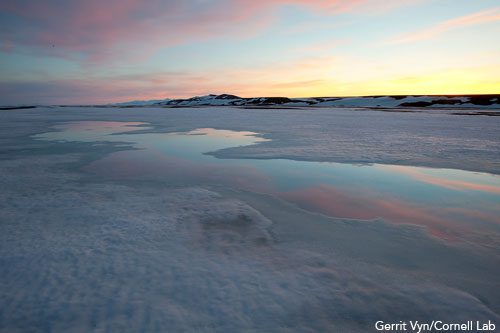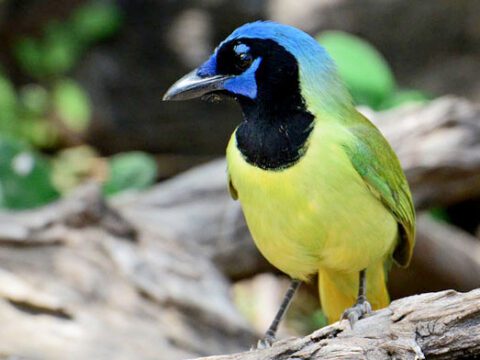Finding Help for the Spoon-billed Sandpiper
Images and text by Gerrit Vyn, Cornell Lab producer June 17, 2011

The Spoon-billed Sandpiper is one of the world's most critically endangered birds. 

This summer, UK and Russian scientists journeyed to the sandpiper's breeding grounds to try to save it. 

This White Wagtail was one of the first migrants to return to its breeding grounds. 

Our photographer Gerrit Vyn is along to document the bird's natural history and surroundings. 

As summer sets in, Rock Ptarmigans are starting to molt into brown summer camouflage.
In the arctic tundra of eastern Russia, a sparrow-sized shorebird with a one-of-a-kind beak is facing extinction—and a few scientists are doing all they can to save it. In recent years the Spoon-billed Sandpiper‘s population has dropped by a staggering 25 percent per year. Fewer than 200 pairs now remain. So this year, shorebird experts from the Wildfowl and Wetlands Trust and Birds Russia are enacting an emergency plan to begin a captive breeding program (read their expedition blog here). Their hope is to stall the species’ decline and give scientists time to learn why it’s happening.
The Cornell Lab’s Gerrit Vyn, a photographer and video producer in our Multimedia Program, is in the field along with the scientists. He’s there to record, for the first time, the natural history of the Spoon-billed Sandpiper on its breeding grounds in high-definition video and sound. He’ll be there throughout the brief arctic summer, and we’ll feature a few posts from him during his stay in Meynypil’gyno, Russia (see a map). In this first installment, he describes what’s known about the threats facing the bird, as well as his first encounter with Spoon-billed Sandpipers in the wild. –Hugh Powell
The Spoon-billed Sandpiper is likely the most critically endangered bird species in the world. It breeds on remote coastal tundra and migrates to the south through key staging sites in Kamchatka, Korea, and Japan. It winters across South China, Vietnam, Thailand, Myanmar, and Bangladesh. But with fewer than 200 breeding pairs remaining, unless the rate of decline is stemmed the Spoon-billed Sandpiper will become extinct in a decade.
Thus far, determining the most important factors behind its population decline has been difficult—a common problem for migratory species that travel large distances and live in multiple locations throughout the year. The two main factors currently thought to be at the root of the decline are habitat loss around key migration sites in the Yellow Sea, where tidal estuaries are being walled off and turned into land; and subsistence hunting pressure at wintering sites. (Some local people use nets to trap larger shorebirds for food; Spoon-billed Sandpipers, though too small to eat, sometimes end up as casualties.) The loss of habitat to land reclamation is also causing continuing declines in several other shorebird species of the East Asian–Australasian Flyway.
Our destination for this project is the village of Meynypil’gyno—about 500 people living on a long gravel spit at the edge of the Bering Sea. Nearby is the largest known core breeding area of Spoon-billed Sandpipers, where at least 12 pairs bred last year. We arrived in early June, just before the males arrived to begin their courtship flights and nesting.
Just inland from Meynypil’gyno is an area of rolling moraine hills interspersed with small tundra ponds. Beyond that is a range of frigid, unexplored mountains. When we arrived, snow was still deep in many areas and the main water bodies were still frozen, but things were thawing quickly. The weather is cold and windy as is to be expected for most of our stay.
Lately, the snowdrifts have shrunk enough for us to venture farther afield, on foot or by ATV. In the two weeks we’ve been here, the Spoon-billed Sandpipers have returned and many are now incubating eggs. I’ve just come back to town after three days camping out, watching and recording these marvelous birds. (Read more about what the scientists have been doing at the Wildfowl Wetlands Trust expedition blog.)
Elsewhere, bird migration has been in full swing. When the winds are right there is constant passage of Common and Steller’s Eiders, Harlequin Ducks, scoters, Long-tailed Ducks, Brant, four species of loons, assorted auks, Black-legged Kittiwakes, and regular flocks of 50 or more Pomarine Jaegers. Shorebirds are moving too, including Ringed Plover, Lesser Sand-Plover, Red Knot, Ruff, Wood Sandpiper, Dunlin, Red-necked Stint, and others.
There’s been mammal migration too: Gray Whales swimming within 20 feet of the gravel shore. Many are feeding and just passing by but others are using the coarse gravel to rub their bodies free of barnacles and other skin irritants. I stood knee deep in the surf and watched a group of three whales, within 15 feet at times, rolling, splashing and spyhopping (bobbing vertically in the water to look around). It is tempting to dive into the frigid waters with them if only for a moment.


All About Birds is a free resource
Available for everyone,
funded by donors like you






